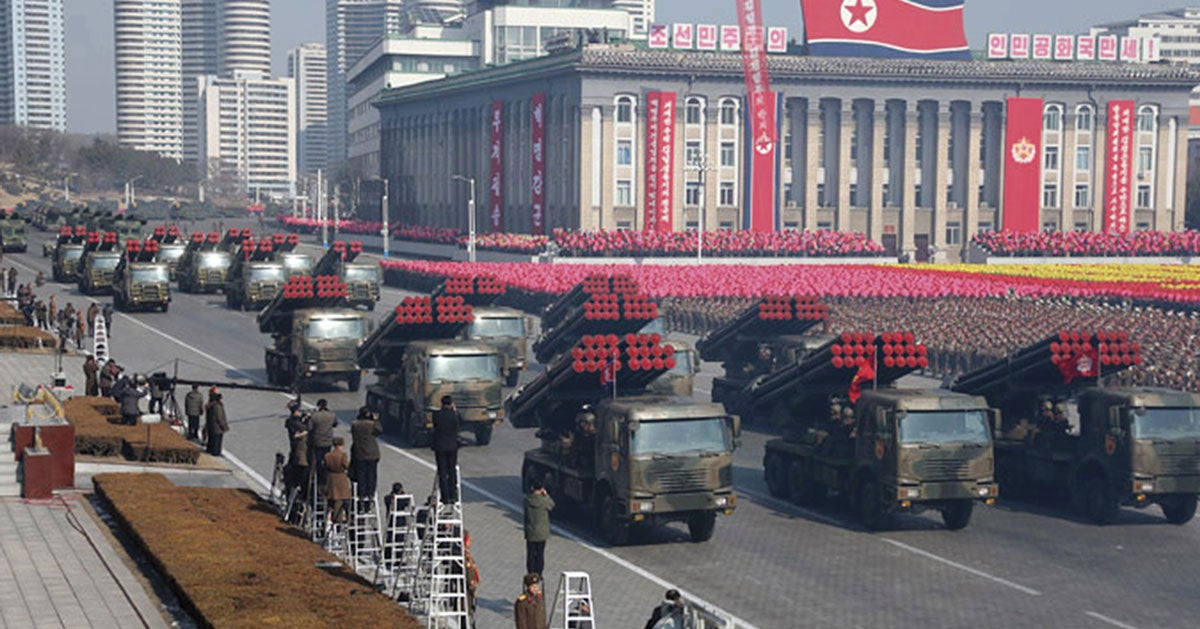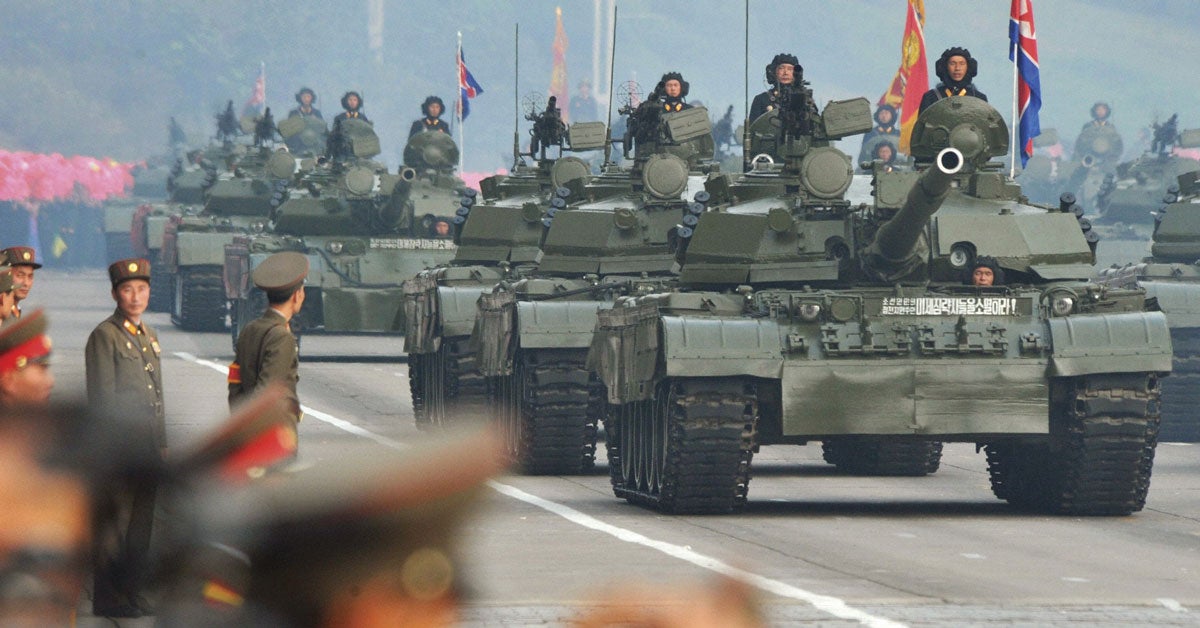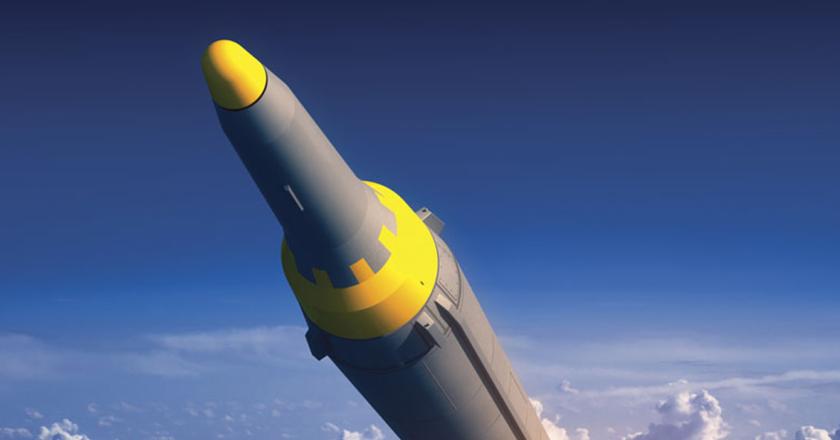Since assuming power in 2011, North Korean leader Kim Jong-un has exponentially increased testing of nuclear weapons and the missiles needed to deliver them against the United States and its allies. Experts assess that the regime now has 30 or more nuclear weapons. In 2017, North Korea tested a weapon at least 10 times more powerful than those used in 1945, indicating it has developed highly destructive hydrogen bombs.
North Korea likely already has the ability to hit South Korea and Japan with nuclear weapons on medium-range ballistic missiles. The regime also has chemical and biological weapons programs, the latter demonstrated when it used deadly VX nerve agent to assassinate the leader’s half-brother in a crowded civilian airport in Indonesia. Pyongyang is also nearing deployment of intermediate-range missiles to threaten critical U.S. military bases in Guam, a key node in the defense of U.S. allies in Asia.
North Korea is on the cusp of having the ability to reach the American homeland with nuclear-tipped intercontinental ballistic missiles (ICBMs). Pyongyang has successfully tested missiles that can reach the entire continental United States all the way down to Florida. Earlier this year, then-CIA Director Mike Pompeo warned that the regime may complete the program within “a handful of months.”
Pyongyang has frequently threatened to use its nuclear weapons to turn Washington into a “sea of fire.” The regime also announced that some of its missile launches were practicing nuclear airbursts against U.S. bases in South Korea and Japan.
Pyongyang’s Multiple Objectives
For decades, debate has raged over North Korea’s motivations for developing nuclear weapons. Initially, the dispute was whether Pyongyang was building a military capability or merely a negotiating chip to be bargained away for economic and diplomatic benefits. Today, some experts assess North Korea seeks only a nuclear arsenal sufficient to deter a U.S. attack. Conversely, others perceive a desire to use nuclear weapons to achieve unification of the Korean Peninsula on the North’s terms or to attack the United States.
The U.S. Intelligence Community has “long assessed that Pyongyang’s nuclear capabilities are intended for deterrence, international prestige, and coercive diplomacy.” From Pyongyang’s perspective, having nuclear weapons makes eminent sense since it concurrently fulfills several long-standing foreign policy objectives:
- Regime survival, by deterring allied attacks or retaliations in response to North Korean provocations;
- Source of national pride, by achieving equal status with the United States;
- Domestic legitimacy and international prestige for the leadership;
- Tremendous military power, overcoming deficiencies in conventional forces to achieve reunification;
- Formidable leverage for coercive diplomacy, to wrest concessions and benefits;
- Undermining of the U.S.-South Korean alliance, by sowing doubt that Washington would come to Seoul’s defense once the American homeland is under nuclear threat.
Regime Survival. North Korean leader Kim Jong-un claims his nuclear force constitutes” a powerful deterrent that prevents [the United States] from starting an adventurous war.” Pyongyang justifies its nuclear weapons as guaranteed protection against the U.S. “hostile policy” of intimidation, military attacks, and regime change against authoritarian regimes. The North Korean military supreme command declared: “This land is neither the Balkans nor Iraq and Libya.”
Pyongyang’s military threats, including the colorful taunt to turn Washington and Seoul into a “sea of fire,” are usually issued in a conditional context, depicting them as a response to any U.S. attack. In his 2018 New Year’s Day speech, Kim Jong-un declared: “As a responsible nuclear weapons state, our Republic will not use a nuclear weapon unless its sovereignty is encroached upon by any aggressive hostile forces with nukes.”
North Korea Stands Alone. Contrary to widespread misperception of a close Chinese-North Korean political relationship, Pyongyang feels threatened by its neighbor to the north as well as by the United States since Beijing has acquiesced to joining in sanctions against North Korea. All three generations of North Korean leadership have warned of the dangers of Chinese intimidation. A traditional Korean adage depicts the peninsula as a “shrimp amongst whales.”
The North Korean nuclear program was born in the 1960s due to the perception that the regime couldn’t rely on either of its superpower allies—the Soviet Union and China—for its defense. Moscow was seen as having abandoned Havana during the Cuban missile crisis, and Beijing refused to share information from its nuclear tests.
North Korea sees nuclear weapons as a means of gaining equal status with the United States. Pyongyang has long sought formal recognition as a nuclear weapons state in order to deal with Washington from a position of equity. North Korean Foreign Minister Ri Yong-ho told the UN General Assembly that Pyongyang’s ultimate goal is to “establish the balance of power with the U.S.”
Leadership Legitimacy. Even more than his father and grandfather, Kim Jong-un has linked his personal prestige to the country’s nuclear and ICBM programs. Lacking the revolutionary credentials or lengthy government tenure of his predecessors, Kim embraces the programs and the breakthroughs in recent years as his exclusive contribution to fulfilling long-standing regime objectives and defending the country.
North Korean official media frequently release photos of Kim attending missile launches, lauding him as the visionary and driving force. Kim is thus able to convey an image of infallibility and invincibility which helps secure his control of power. By declaring that the nuclear button is on his desk, Kim portrays himself as uniquely qualified to defend the country.

North Korean troops march through Kim Il-sung square in Pyongyang on the eve of the 2018 Winter Olympics in South Korea.
credit: KCNA/UPI/Newscom
Military Capability. Nuclear devices are the ultimate weapon and give North Korea the power to wreak havoc on its neighbors and the United States. Pyongyang already has the ability to target South Korea and Japan with nuclear weapons and is nearing completion of longer-range missiles to hit U.S. bases in Guam and the American homeland. Last year, the regime successfully tested two ICBM variants and an H-bomb with at least 10 times the explosive power of the Hiroshima and Nagasaki atomic bombs.
North Korea has long sought to drive a wedge between the United States and its partners by depicting Seoul’s alliance with Washington as the impediment to improved inter-Korean relations and eventual reunification.
North Korea is developing several means to ensure greater survivability of its missile forces, enhancing both a preemptive first-strike and retaliatory second-strike capability. Pyongyang is testing several different solid-fueled missiles which require less fueling time, along with mobile ground-based launchers and submarine-launched ballistic missiles. The regime has also practiced missile launches under wartime conditions by firing them from diverse locations throughout the country and conducting salvo launches of several missiles simultaneously.
Enhancing Coercive Diplomacy. Attaining an unambiguous nuclear ICBM capability could lead Pyongyang to perceive it has immunity from any international response. This might tempt the regime to act even more belligerently, trying to intimidate the United States and its allies into accepting North Korean diktats. The regime could also use rising international fear of its nuclear prowess to pressure other Six-Party Talks participants to abandon denuclearization as their goal and instead accept limitations on North Korea’s nuclear programs in return for diplomatic and economic concessions.
Decoupling the Alliances. North Korea has long sought to drive a wedge between the United States and its partners by depicting Seoul’s alliance with Washington as the impediment to improved inter-Korean relations and eventual reunification. Characteristically, Kim Jong-un declared in his 2018 New Year’s Day speech: “the North and the South improve the relations between themselves and take decisive measures for achieving a breakthrough for independent reunification” without U.S. interference. Doing so, however, requires South Korea to “discontinue all the nuclear war drills they stage with outside forces [and] refrain from any acts of bringing in nuclear armaments and aggressive forces from the United States.”
Pyongyang’s approaching ability to target the continental United States with nuclear weapons has aggravated allied concerns about U.S. capability, resolve, and willingness to defend their countries. This trend is most prevalent in South Korea, which fears the United States “wouldn’t trade Los Angeles for Seoul.” This, coupled with growing anxiety that the United States is contemplating a preventive attack on North Korea, has led some in South Korea to advocate a more independent policy from Washington.

North Korean tanks take part in a parade to mark the 65th anniversary of the founding of the Workers’ Party of Korea in Kim Il-sung Square in Pyongyang on October 10, 2010.
credit: Kyodo/Newscom
How Does North Korea Achieve Its Objectives?
For decades, North Korea was able to keep the world at bay as it pursued nuclear weapons and ICBM programs, first in secret and then in open defiance of UN resolutions. The regime was able to do so through a comprehensive multi-faceted strategy of “deny, deceive, and delay.”
Preparing the Battlefield—Demanding a Price for Attending Negotiations. North Korea often achieved several objectives prior to even entering the negotiating venue. Pyongyang would fortify its bargaining position by conditioning its return on receiving preliminary concessions from its opponents as well as determining the agenda so that it reflected North Korean policy priorities.
By holding out the promise of returning to the talks rather than issuing an outright rejection, North Korea sought to portray itself as a reasonable negotiating partner. Pyongyang would signal it was interested in resuming negotiations while concurrently rejecting U.S. preconditions by characterizing them as insufficient. Doing so put Washington on the defensive and susceptible to additional pressure from China (and from South Korea, when it had Left-leaning governments) to provide greater U.S. “flexibility.”
Pyongyang’s approaching ability to target the continental United States with nuclear weapons has aggravated allied concerns about U.S. capability, resolve, and willingness to defend their countries.
“Good Cop, Bad Cop”—Creating the Illusion of Factionalism. North Korea long cultivated the image of factional infighting between “engagers” and “hardliners” as a negotiating tool. In fact, the ministries of foreign affairs and defense were simply playing the roles of good cop and bad cop in order to gain maximum diplomatic and economic benefits. In the words of a Korean adage, “the same animal has sharp claws and soft fur.”
Raising Brinksmanship to an Art Form. Pyongyang escalated tensions to define negotiating parameters and extract maximum benefits for minimal concessions. North Korean brinksmanship raised the price of an eventual deal, slowed down the negotiating process until opponents were willing to meet North Korean terms, and created a parallel crisis to divert attention from a negotiating impasse.
North Korea’s escalation is opportunistic rather than reactive to U.S. actions. By moving up the escalatory ladder, North Korea retains the initiative and controls the pace of the game, forcing the United States and others to respond. Raising tensions may gain Pyongyang what it desires or at least expose fault lines in a coalition that North Korea can then exploit. Pyongyang believes it can force the United States to negotiate either by applying leverage directly on Washington or indirectly through its allies.
Two-track Diplomatic Strategy. Pyongyang often used a combination of threats and assurances to garner diplomatic and economic support from China, Russia, and South Korea by raising the specter of a deteriorating security situation.
Pyongyang’s two-track strategy complicated U.S. attempts to gain Chinese and Russian support for imposing sanctions. North Korea’s seeming reasonableness encouraged Beijing and Moscow to resist tough enforcement of the trade sanctions, let alone U.S. demands for additional sanctions beyond those mandated by the UN.
Inching Across the Redline. Pyongyang used the years of negotiating foot-dragging and delays to augment its stockpile from an estimated one to two nuclear weapons at the end of the 1990s to enough fissile material for approximately 30 or more weapons today.
Under Kim Jong-il, North Korea’s strategy had been to build slowly toward an escalatory act, thereby allowing the United States and its allies sufficient time to offer new diplomatic or economic inducements. On those occasions when North Korea carried out the act, it followed with several months of calm to allow all countries to become accustomed to the new elevated status quo prior to initiating the next lengthy provocation process.
Unlike his father, Kim Jong-un has eschewed engagement, maneuvering for negotiations, and charm offensives. Kim fils preferred an all-out sprint to cross the finish line of a viable nuclear weapons and ICBM capability. He lost an opportunity to induce liberal Presidents Obama and Moon Jae-in to offer benefits and move away from pressure tactics. Kim’s hardline strategy drove the international community into greater consensus on the need to punish and pressure the recalcitrant regime.
But Kim’s 2018 New Year Day speech may have marked a turning point. In it, he extended an olive branch to Seoul which was quickly grasped by President Moon in order to lower tensions on the peninsula. Bilateral discussions led to an agreement for a North Korean team to join the Olympics in South Korea. Skepticism abounds as to how sincere or effective Kim Jong-un’s charm offensive will be, since all previous Korean reconciliation efforts collapsed.
Too High a Cost. If Kim shows a willingness to return to nuclear negotiations, it would come with a price. Pyongyang has always coupled diplomatic outreach with an ambitious list of demands, including:
- Military: the end of U.S.-South Korean military exercises, removal of U.S. troops from South Korea, abrogation of the bilateral defense alliance between the United States and South Korea, cancellation of the U.S. extended-deterrence guarantee, and worldwide dismantlement of all U.S. nuclear weapons;
- Political: establishment of formal diplomatic relations with the United States, signing of a peace treaty to end the Korean War, and no action on the U.N. Commission of Inquiry report on North Korean human rights abuses;
- Law enforcement: removal of all U.N. sanctions, U.S. sanctions, EU sanctions, and targeted financial measures; and
- Societal: restrictions on South Korean constitutionally protected freedoms of speech and assembly, including suppressing the publication of “insulting” articles by South Korean media and forbidding anti-North Korean public demonstrations in Seoul.
Conclusion
How one interprets the motivations driving North Korea’s nuclear weapons program influences one’s views on the appropriate U.S. policy response. A belief that the primary purpose is defensive leads to advocacy for pursuing a negotiated freeze on the regime’s nuclear program. Theoretically, a freeze could lead to denuclearization.
At the other end of the spectrum, an assessment that Pyongyang’s dominant reason for a nuclear arsenal is to invade South Korea and achieve Korean unification leads to advocacy for a U.S. preventive attack before Pyongyang achieves an ICBM capability. A middle viewpoint is that the North’s nuclear weapons are more than a benign defense mechanism, but that the regime is unlikely to initiate an invasion as long as the U.S.-South Korean alliance remains strong. As such, the best policy for the U.S. is a comprehensive strategy of deterrence, containment, pressure, and eventual regime change.
Mr. Klingner is a senior research fellow on Northeast Asia at The Heritage Foundation.
